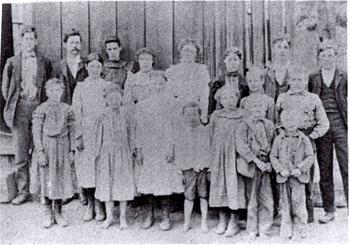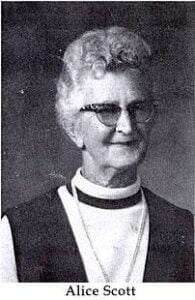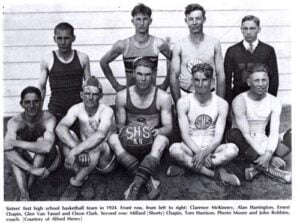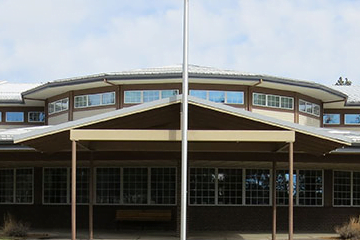District / Why Sisters? / Our History
The first school in the Sisters school district, then District #9, Crook County, was built about 1885 although Crook County records show money had been allotted to the district in 1883. There were 30 children on the census in 1885.
This school building was a log cabin located two miles north of Sisters near the Lundy Ranch, which may have been a central location for the school children to attend. The cabin was made of hewn logs when most of the houses were built of round logs. This building was moved to Sisters around 1909 and used as a dwelling.
The next school was a one-room building located near the present site of the Park Motel. This was the first school building in Sisters and was built about 1890. In 1900, it was replaced by a two-room building erected where the present grade school building stands.
In 1912, the old building was replaced by a six-room structure which served the district for 42 years. For several years only two rooms were used as classrooms. Two teachers were employed. One teacher taught the first through six grades and the other the seventh, eighth and the first two years of high school. A third room on the first floor, which was connected to one of the rooms in use by a sliding door, was used for programs and meetings. In the early years this building was in use there was a long shed in the rear. Children who came from a distance rode horseback or came in a buggy. They tied their horses in the shed and there the horses stood all day.
In 1913, so many homesteaders were living in the Lower Squaw Creek area, which was also a part of District #9, that the district maintained a one-room school on the William Wilt homestead. This was kept open for two years. The first teacher was Mrs. Earl Updike; and the second year Tillie Davidson Wilson taught six children ranging from second grade through the eighth grade. Following this, the children were either brought to school at Sisters by their parents or were boarded in Sisters at the expense of the district.










In 1920, a third teacher, William Kelty, was hired to teach the first two high school grades. A room upstairs was opened for their use. In 1923 a four-year high school program was offered and a second high school teacher was employed. These two teachers were H. L. Moody and John P. Robbins.
In 1925, a gymnasium was added to the school building, but in the winter of 1927 it was destroyed when the roof caved in. A heavy load of snow was the cause of this. The present gym was built on the same site soon after.
The old brick high school building, finished in 1937, was built with local taxes and federal aid.
In 1949, the primary building, a four-room quonset hut, was erected and named in honor of Earl E. Russell, first mayor of Sisters. It consisted of four main classrooms, a library and an office. A gymnasium was built close by a short time later.
A new grade school was built in 1954 to replace the one built in 1912. There were four classrooms, an office, a library, a kitchen, a multipurpose room and a basement. The main building is brick and was joined to the multipurpose room, which was a wooden structure. This room was just what it implied. It was used for meetings, programs, dancing, physical education and hot lunch dining room.
In the grade school office there was a register dated 1901-1905. Dayton Elliot taught in 1901. Other teachers’ names appearing in the early register are: Jessie Andrews, Daisy Hale, Charles Lewis and Hubert Scoggins. Among the students in 1901-1905 are several of the older generation still living in 1970. They were Belle Claypool, Lynn Wilson, Jesse Wilt and Clarence Wilt. In the register dated 1911-1912 we find the following names of the students that still lived in 1970: Homer Grogan, Dewey Grogan, Harry Dinkel, Clyde Duckett, Norma Duckett, Alice Grogan and Ethel Dinkel Wilson. The names of those living in 1970 who were students in 1912-1913 are: John Wilson, Allen Harrington, Lantis Griffith Jones, Elba Taylor, Georgia Woods Haner, Mabel Smith O’Hara, Eda Towne, Ethel Vincent, Harold Allen, Phelma Cobb Perry and Irel Harrington Zastera.
Of special interest are the types of teacher certificates and the county institutes attended. A state diploma was issued on graduation from a two-year normal school. The certificate was valid for five years, but at the end of three years’ successful teaching a life certificate was granted. A one-year certificate was given on the completion of a teacher’s training course given in high school. This could be renewed for another year, after which the teacher must go to normal school or take the examinations given by the state. A one-year certificate was also granted upon passing grades in an examination given by the state in the following subjects: Arithmetic, Civil Government, Geography, Grammar, United States History, Orthography, Physiology, Reading, School Law, Theory and Writing. Grades of 90% or above exempted a teacher from further examinations in any subjects in which a grade had been received unless he ceased to teach for a period of three years. The following is a sample of questions given to an applicant for a teacher’s certificate:
June, 1925: United States History
- Name and identify by nationality five men who took prominent part in the early exploration of North America.
- What two great Englishmen defended the rights of the American colonists in England?
- State the two principal weaknesses of the United States Government under the Articles of Confederation.
- Name two men who were most active in the agitation for a stronger central government.
- In what way did the members of the Constitutional Convention of 1787 disobey?
- What three great compromises were embodied in the new Constitution?
- What made slavery a national issue?
- Tell what Douglas meant by “Popular” or “Squatter Sovereignty.” Was it democratic?
- What industrial and economic changes have taken place in the South since the Civil War?
- What is the function of the Interstate Commerce Commission?
- Name five presidents from 1868 to 1900.
- Name three constitutional amendments adopted since 1900.


The only professional magazine listed in the old registers was the “Normal Instructor.” This magazine was purchased by the teacher.
In the 1920’s and 1930’s, all the Oregon teachers were given a list of professional books, one of which had to be read each year. A written report on the book had to be sent to the state superintendent’s office and if it was satisfactory, the teacher was issued a certificate of required reading which had to be registered in the county superintendent’s office. A partial list of these required books and their authors follows: “Supervised Study in the Elementary School,” by Hall and Quest; “Changing Conceptions of School Discipline,” by Harris; “Before the Covered Wagon,” by Parrish; “Silent and Oral Reading,” by Stone; “The Improvement of the Written Examination,” by Ruth, and “General Methods of Teaching in Elementary Schools,” by Parker.
In 1902, the average teacher received $40 per month for as long as the school was in session. In 1914 the average was $60 and in 1918 it was $80. This included payment for janitor work. During this period the school district paid its teachers in warrants which were discounted when cashed at the banks. Sometimes the banks refused to take these warrants; then the teachers would have to find other buyers for them. People in the Sisters district who had money to invest bought these warrants at face value.


During the depression many parents had a hard time feeding their families adequately. Some of the children came to school with nothing but cold fried potatoes for lunch. The Sisters Civic Club decided to do something about this, so it began serving one hot dish to the children who could not go home for lunch. A long narrow room on the north end of the gymnasium became the dining room and this room had a small kitchen opening into it. Most of the Civic Club meetings had been held here. The club had already furnished the room with benches and tables and had enough dishes to serve the children, but it still needed food to serve and people to prepare and serve it. The community backed the Civic Club in its venture and food donations began to come in from the stores and from some of the parents who had milk and vegetables to spare. The club solved the problem of preparing and serving the food by doing it themselves. Each day two new members took over the duties of the day until all had served; then they began with the first two again. In this way the burden was shared by all of them and the children had some hot food besides their own sandwiches, which they brought when they could. The Civic Club kept this up until times were better and the need was not so great.
In the early 1940’s, the Parent-Teachers Association, which had recently been organized, began sponsoring a hot lunch program. By this time they were receiving state aid and were also charging a small fee for each lunch served. This enabled them to hire a cook and a helper. The P.T.A. did this until the school took over the program.


In the middle 1930’s, Sisters had a strong basketball team, playing Bend, Redmond, Prineville and LaPine among others. Quoting from the January 27, 1936, Bend Bulletin: “Sisters veteran basketball team with Wilson, forward who made 18 points, as its spark plug, gave the Lava Bears of Bend a real scare late in the conference game played Saturday night in the McKenzie Pass town, but were unable to overcome an early lead and lost to Bend 38 to 31. In the final quarter, Coach M. A. Cochran sent in his entire string of reserves, when Bend was leading 34 to 19. Against the Bend reserves, Sisters, with Wilson and Spoo giving some of the finest exhibition of basket shooting seen on a Central Oregon court this season, started “going to town” and Coach Cochran was forced to bench his reserves and send his first string back into action.
“Wilson’s 18 points were the most made by any member of either team, Olson winning high point honors for the Bend team, with 13 to his credit.” The Sisters team was coached by Lloyd Baker.
By 1956 the schools were classified according to the size of the school. In that year the team went to the Class B state tournament. This happened again in 1957 with George Estes as coach. Members of the team were: Mike Smith, Willis Winkle, Ron Phillips, Stan Williams, Cordon Mouser, LeRoy Larson, Carroll Raines, Mike Nesbitt, Denny Reese and john Thompson. They also played the state tournament another year.
A football team was not organized until the year 1930-31. In 1931, Clyde Bonney coached an 11-man team consisting of these players: Willis Patterson, Guy Patterson, Jimmy Tynon, Willis Spoo, Carl Brenchley, Homer Shaw, Howard Shaw, David Zumwalt, Luke Rief, Carl South, Pete Leithauser and Lewis Woods. Because they didn’t have men enough for two teams, Mr. Bonney divided the boys into small groups and had them practice the different plays. They practiced on the old baseball diamond south of the business district of Sisters. This team started off to a good beginning, but due to the sudden death of Mr. Bonney, football playing ended for a number of years as the following teachers were not football coaches. This was the only 11-man team that Sisters has ever had.
Football did not return to Sisters high school until the early 1950’s. At this time a fine football, baseball and track field was developed east of the Earl Russell school. The clearing of this land was made a town project, with Harold Barclay supplying the large equipment that was needed. This field was seeded to lawn and provided a wonderful place for physical exercise for both grade and high school students. Later a field for track only was developed, joining the football field on the east; and an area south of the Earl Russell building was made into a tennis court.
The three schools were close together in campus style, with the athletic fields an extension of the Earl Russell playground. In the middle 1950’s, a sign was erected near the tennis courts and facing the highway. This sign said, “Home of the Sisters Outlaws.” “The Outlaws” was the name chosen by the Sisters high school athletic group and applied to all of the teams in sports.
In 1957, an eight-man football team won the State Class B championship and again in 1959 and 1961. Members of the 1957 team were: Stan Seigner, Gilbert Daniels, John Shaw, Sam and Robert Hewitt, Douglas Hockett, Richard Bowers and A. J. Demaris. It was in 1957 that Ron Phillips was chosen to play with the Shrine East-West team because of his outstanding performance in the local team. Willis Winkle played on the Central Oregon All-Star football team that same year.
Of special interest and enthusiasm for students and alumni and patrons of Sisters High School were the homecoming game and festivities each autumn. A street parade preceded the game. This featured the appearance of the queen, the school band, cheerleaders and floats prepared by the different high school classes. There were also the clown acts depicting the fate of the rival team. In the evening a dinner, followed by a dance, was held in the multipurpose room.
The six-room grade school building that was torn down in 1954 had a belfry with a large bell in it. The bell was saved and later put into a frame and placed on the grade school lawn. It became a sort of victory bell for the high school football team, as it was rung whenever our team was victorious. However, this bell proved to be irresistible to a number of youngsters in the community and its voice was heard at all times of the day and night. So, to keep the bell where it was, the clapper was removed.
On December 5, 1964, the Sisters School was given an Honor Award for a “Distinguished Health and Physical Education Program” by the Oregon Education Association. This program was under the direction of Roy Runco, with Carleen Sorenson coaching the girls.
In 1955, William Edwards instructed a group of students who were interested in skiing. This class met once a week at Hoodoo Bowl, although some of the students skied there over the weekends. No credits were given for the class. The skiing continued for several years under the direction of Tom Cox.
Other extra-curricular activities were music, band and drama. In the early 1930’s, the school presented a music festival under the direction of Mary Sandford, eighth grade teacher. Groups of parents, working with the teachers, made the costumes which contributed much to the beauty of the production.
In the early 1950’s, a music teacher was sent to each grade school one day a week by the county. A music festival was presented once a year under her direction with each county school participating. This was held in a different school each year. In later years the district hired its own music teacher.
As early as 1936, the high school had an orchestra. This was directed by Lloyd Baker. In later years, band, orchestra and chorus were taught.
“Our Team,” directed by Anne Johnson, was taken to the Pacific University One-Act Play Contest.
In 1948, the grade school put on a Thanksgiving parade under the direction of Homer Matson, principal. Each class depicted some phase of Thanksgiving. There was the Mayflower, a boat with sails, mounted on a truck bed with Pilgrims in the Mayflower and Indians and Pilgrims marching. There was a float showing “The Four Freedoms,” also a Pilgrim home of corrugated cardboard, mounted on a truck, accompanied by Pilgrims and Indians. One class presented the theme “Be Thankful for Food,” with marching children carrying a banner and many kinds of food. The first grade led the parade with their band. The weather was so cold and windy that the parade was never held another year.
The Sisters High School held the first bloodmobile drive in Sisters in 1951, in cooperation with Deschutes County Red Cross. This was done in memory of their classmate, Gene Christy, who had lost his life in the Korean .War.
The 1952, “Outlaw” Sisters High School annual, gives a very good description of this event: “December 10, 1951, will long be remembered in Sisters as ‘Gene Christy Blood Donation Day.’ This will commemorate the first time a school in the state of Oregon volunteered to take over the responsibility of helping the Red Cross Bloodmobile.
“Sisters High School students haunted Sisters residents until 274 pledge cards were collected which gave Sisters the highest per capita rating in the state, but almost 175 of these were turned away because their blood was undesirable.
“With the coming of the bloodmobile, the students swung into full action: boys with cars gave transportation to the gymnasium, babysitters were provided for the mothers who needed them, free of charge, while they donated.
“There was a hundred percent donation by the high school faculty, and one student, Evelyn Hannan.
“A hospital unit was set up in the gymnasium. Beds, equipment, desks, chairs and nurses gave a very business like atmosphere to the scene.
“The Red Cross nurses managed the medical and technical part of the work and supervised the other duties: typing, taking temperatures and serving refreshments, which were managed by the students.
“The blood drive gave Sisters first rate publicity which included top stories by Sam Hayes, Gabriel Heater, Frank Hemingway, and front page spreads in the Bend Bulletin, Portland Oregonian and Journal.
“But most important of all, is the thought that prompted the blood donation, that other schools will pick up the idea and help those boys overseas.”
This bloodmobile drive, known as “Gene Christy Day,” became an annual event for the Sisters High School for a number of years. In 1952, Evelyn Hannan and Ivan Raines were the co-chairmen for the drive. In 1955, there were four co-chairmen: Shirleen Harrington, Sondra Reese, Bert Hockett and Dale Brandon. The quota was 80 pints of blood, with 72 pints given. In 1957, the co-chairmen were: Kathleen Larson, John Thompson, and Barbara White. The quota was 70 pints of blood, with 57 pints given.
The blood drive of 1958 was headed by co-chairmen Karen Ryan and Tim Wakefield. This drive was quite successful as 66 pints of blood were received with a quota of 60. On April 29, 1969, a certificate of appreciation was given to the Sisters High School for “their continued interest in promoting the Blood Program and excellent accomplishment” by the American National Red Cross Deschutes County Chapter.
Again in 1960, the Gene Christy Day blood drive proved very successful, with Bonnie Dickerson and Dale Tackitt as co- chairmen. The quota was exceeded, with 54 pints donated. A certificate of appreciation was awarded to the students of the Sisters High School for outstanding cooperation with the American Red Cross Blood Program. It was given by the Pacific Northwest Regional Blood Program.
In 1961, the 50-pint quota was reached, with Rose Hammack and Gilbert Daniels heading the drive. In 1962, the co-chairmen were Evelyn Cutsworth and Tom Craven. The last blood drive given by the Sisters High School in cooperation with the Red Cross bloodmobile was in 1966.
Numerous scholarships were available to Sisters high school graduates over the years. The most coveted one was the Ronald Olmstead Memorial Scholarship, available only to the young men of the senior class. Ronald, son of Mr. and Mrs. Paul Olmstead, Sr. of Sisters was drowned in the swift waters of the Metolius River while on a fishing trip. This happened only a few days after his graduation from high school. Ronnie had been an outstanding student and athlete and had been very popular with both students and teachers alike. He graduated with the class of 1956.
The scholarship, provided by Mr. and Mrs. Harold Barclay, continued from 1957 until the Sisters high school students were transported to another school.
Sisters was also one of the first high schools in the area to teach conservation, which it did under William Edwards in the middle 1950’s. Part of these classes were conducted in the forest.


Since 1968, the high school students are being tuitioned to the Redmond High School. This came about because of the change in the tax system on federal timber.
The people of this area have been proud of their school and many young people have been given good high school educations. The interest of the citizens has been a big factor in keeping the school progressive. It has long been the center of the educational and social life of the community. A fair percent of our graduates have gone on to college and from there into businesses or professions of their choice.
From That Was Yesterday: A History of the town of Sisters, Oregon and the Surrounding Area by Tillie Wilson and Alice Scott. First printed in 1974 and reprinted by the Friends of the Sisters Library in 2000.













